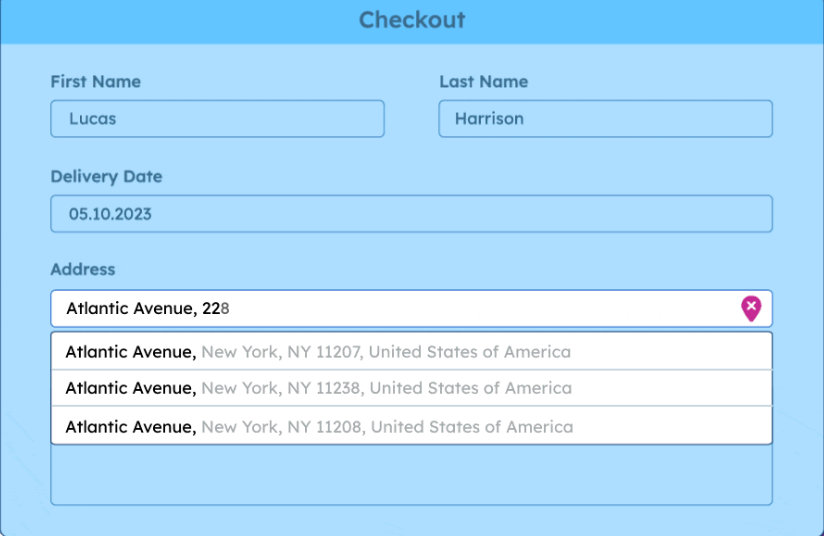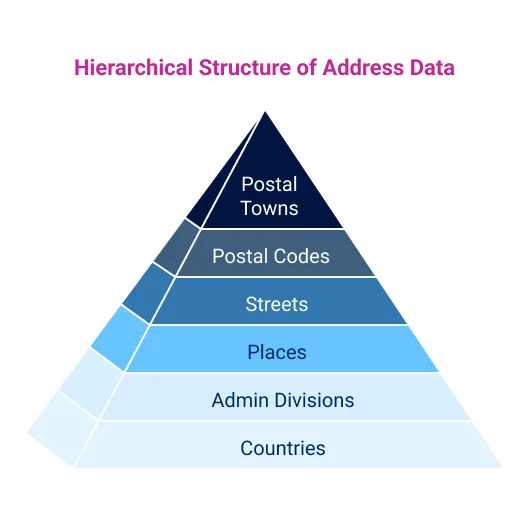Introduction
In today’s digital landscape, the accuracy and efficiency of address entry have become crucial factors in determining the success of online businesses. How users input addresses significantly affects business outcomes, whether managing an e-commerce platform, a logistics operation, or a customer database.
This comprehensive guide will show you how to explore the world of address autocomplete and autofill solutions, with insights into how quality location data serves as their foundation.
💡 Use accurate ZIP code data to enhance user experience and improve data quality. Our worldwide ZIP code data is updated weekly, relying on over 1,500 sources. Browse GeoPostcodes datasets and download a free sample here.
Understanding Address Autocomplete
Address autocomplete revolutionizes online forms by suggesting complete addresses as users type, turning a manual process into an efficient experience.
The system analyses user input in real time, comparing it against a comprehensive database of validated addresses, leveraging structured data to ensure accuracy and consistency. It then presents relevant suggestions that users can select with a single click.
The technology goes beyond simple text matching, incorporating complex algorithms that understand various address components, including countries, cities, postal codes, and streets.
For instance, when a user begins typing “123 Oak,” the system can suggest “123 Oak Street, Boston, MA 02108,” saving significant time and ensuring accuracy in the process. The success of these systems depends entirely on the quality and comprehensiveness of their underlying location data.


Key Benefits of Address Autocomplete
Address autocomplete has numerous benefits beyond convenience. Let’s examine how it benefits both businesses and users.
Enhanced User Experience
The modern user expects seamless interactions with digital platforms, and address entry is no exception. Address autocomplete reduces the friction in form completion by minimizing the number of keystrokes required and eliminating the need to remember exact address details.
Consider a scenario where a customer completes a purchase during their lunch break – the ability to enter an address with just a few keystrokes can make the difference between a completed transaction and an abandoned cart.
When users encounter forms enhanced with address autocomplete, they typically experience a significant reduction in completion time compared to manual entry. This efficiency not only improves user satisfaction but also contributes to higher conversion rates across various business processes.
Improved Data Quality
Data quality stands as a cornerstone of successful business operations. Address autocomplete serves as a powerful first line of defense against the ingestion of inaccurate address data.
By suggesting only validated addresses, the system effectively prevents common issues such as typos, formatting inconsistencies, and non-existent addresses.
The impact of improved data quality extends throughout an organization’s operations. For instance, shipping companies using address autocomplete systems report significantly fewer delivery failures due to incorrect addresses.
Increased Operational Efficiency
The ripple effects of accurate address data touch every aspect of business operations. From logistics and supply chain management to customer relationship management (CRM), having precise location information enables organizations to optimize their processes and make data-driven decisions.
Consider a multinational e-commerce company handling thousands of daily shipments. Accurate address data enables them to:
- Optimize delivery routes more effectively
- Reduce failed delivery attempts
- Minimize customer service interventions
- Improve inventory management across different regions
- Fewer manual error corrections

Better Customer Insights and Targeted Marketing
The precision of address data collected through autocomplete systems provides businesses with invaluable insights for marketing and customer relationship management.
Companies with accurate zip code data can develop more targeted marketing campaigns and better understand customer behavior patterns across different geographical regions.
Accurate address data enables sophisticated market analysis and customer segmentation. For example, a retail chain can analyze customer distribution patterns to:
- Optimize store locations based on customer density
- Tailor product offerings to regional preferences
- Design targeted promotional campaigns for specific neighborhoods
- Improve delivery service areas based on customer concentration
Implementing Address Autocomplete
The successful implementation of address autocomplete requires careful consideration of several key factors, from data source selection to technical integration. You will examine these elements comprehensively to provide a thorough understanding of how organizations can achieve optimal results in their address normalization initiatives.
Selecting a Data Source
The foundation of any effective address autocomplete system lies in its data source. A comprehensive data structure should include multiple layers of information, each contributing to the accuracy and usefulness of the system.
The hierarchical nature of address data requires careful organization of various components. GeoPostcodes provides structured location data that includes:
- Countries at the top level of the hierarchy are complete with ISO codes and specific metadata about available data types. This information helps developers understand what level of detail is available for each country, whether it includes street-level data, postal codes, or other specific elements.
- Administrative divisions vary by country and play a crucial role in address accuracy. For instance, states are essential in the US address system, while other countries might use different administrative levels.
- Places representing cities and towns within each country and administrative division. The relationship between places and countries is clearly defined, as this affects how addresses are formatted in different regions.
- Streets are a mandatory address component in most countries. When a street name is combined with a street number, it uniquely identifies a specific location within a city or town.
- Postal codes form a critical component in addressing systems, frequently serving as a key identifier for location validation and mail delivery. Their implementation varies significantly between countries. For example, the UK uses a detailed postcode system that can identify specific buildings, while other countries employ broader postal zones.
- Postal towns or Primary cities: In some countries, postal towns or primary cities play a crucial role in address formatting and mail delivery. These are officially designated locations used by postal services to route mail efficiently, even if they don’t always reflect the actual municipality where a recipient lives. They are mainly used in the United Kingdom and in the United States to avoid duplicate names and to optimize logistics and delivery speeds.

Data Quality
The success of an address autocomplete system depends heavily on the quality and comprehensiveness of its underlying data. Poor data quality leads to user frustration, delivery failures, and increased operational costs.
GeoPostcodes maintains exceptional data quality in several ways.
Our database undergoes continuous updates reflecting changes in postal systems, new developments, and administrative modifications. This ensures developers access to current address information at all times.
The data encompasses extensive geographic areas, including alternative names and variations for localities. The database contains approximately 142 different nomenclatures for London across various languages, ensuring accurate address matching regardless of user input variation.

It is also noteworthy to mention validation rules. The data incorporates country-specific formatting requirements and addresses structure information, enabling developers to implement precise validation protocols within their systems.
Address autocomplete API Integration
Implementing address autocomplete through API integration requires careful planning and technical consideration. The integration process involves several key steps and considerations.
When integrating an address autocomplete API, it is essential for development teams to prioritize the creation of a frictionless user experience while maintaining system performance. Such integration necessitates the implementation of several key technical features, as shown below.
- Type-ahead functionality: the address suggestion system should present potential matches after the user has entered a minimal character threshold (typically two or three characters), balancing response time with accuracy. Incorporating a measured temporal buffer following keystroke input, such as 5 to 10 requests per second, represents an optimal operational balance for most implementations.
- Limit the number of results: The quantity of displayed results should be dynamically adjusted according to contextual parameters. Fixed limitations need not be universally applied; as an illustration, municipality suggestions may be appropriately constrained to 10 options, whereas street designations may benefit from expanded selection parameters to enhance usability and contextual relevance.
Particular attention should be paid to asynchronous response management, as these responses may not arrive in sequential correspondence with their request timestamps. In fact, short input queries usually require longer processing time than more comprehensive entries due to a higher volume of potential matches.
- Error handling: comprehensive error management protocols are fundamental to sustaining system functionality when confronted with unanticipated input parameters or connection anomalies.
- Performance Optimization: implementing proper indexing, caching, and data management strategies contributes significantly to response time optimization, even during periods of elevated system utilization.
Systems execute more comprehensive search and validation processes upon submission of autocomplete form data. This methodological approach makes the autocomplete more flexible, enhancing performance while ensuring accuracy and a valid address.
Enhancements and Customizations
Address autocomplete systems can be enhanced with various features to improve their functionality and user experience. These enhancements should be tailored to specific business needs and user requirements.
Full-text search capabilities significantly improve the system’s ability to handle spelling mistakes and variations in address input. This is particularly important when dealing with international addresses where users might not be familiar with the exact spellings of foreign places.
Location-based sorting can enhance the relevance of suggested addresses by prioritizing results near the user’s current location. This feature is particularly useful for businesses with specific geographic areas or multiple locations.
If the user’s location is unavailable or irrelevant (e.g., they are not entering their own address), an innovative sorting system should prioritize and present the most relevant address suggestions for a seamless user experience.

Real-World Applications
The implementation of address autocomplete systems has transformed operations across various industries. Let’s examine some specific applications and their impact.
E-commerce
In the e-commerce sector, address autocomplete has become a crucial tool for optimizing the checkout process. Major online retailers report significant improvements in key metrics after implementing address autocomplete:
- Cart abandonment rates typically decrease by 20-30% when address entry is simplified through autocomplete.
- Customer satisfaction scores show marked improvement, with users citing easier checkout processes in their feedback.
- Order fulfillment accuracy increases, reducing the costs of failed deliveries and returns.
Logistics and Supply Chain Management
For logistics companies, accurate address data is fundamental to operational success. Address autocomplete systems help optimize various aspects of logistics operations:
- Route Planning: Accurate addresses enable more efficient delivery route planning, reducing fuel consumption and delivery times.
- Delivery Success Rates: By ensuring address accuracy at the point of entry, companies see significant reductions in failed delivery attempts.
- Warehouse Location Optimization: Accurate customer address data helps companies make informed decisions about warehouse locations and distribution networks.
Healthcare Services
In the healthcare sector, address autocomplete is crucial in improving patient access to care. Healthcare providers use these systems to:
- Help patients locate nearby medical facilities and specialists.
- Ensure accurate delivery of medical supplies and equipment.
- Maintain precise records for emergency services dispatch.
Address Validation and Standardization
Address autocomplete works with several related processes to ensure comprehensive address accuracy. Understanding these components helps organizations implement more effective address management systems.
Address validation verifies that an address actually exists and is deliverable. This process checks addresses against official postal databases and other authoritative sources.
GeoPostcodes provides comprehensive reference data that enables robust address validation, including:
- Complete reference datasets for postal codes and street-level information.
- International address format specifications across different countries.
- Regular data updates that reflect changes in postal systems worldwide.
Address standardization ensures consistency in how addresses are formatted and stored.
This process applies country-specific formatting rules, standardizes abbreviations and terminology, and ensures compliance with postal service requirements. It creates uniformity across your database, making addresses more reliable for shipping, billing, and customer communications.
Conclusion
Throughout this article, we explored the multifaceted nature of address autocomplete systems, demonstrating how quality zip code and street data are their foundation. The complexity of managing location data across different countries, formats, and use cases highlights the importance of having access to comprehensive, reliable data sources.
Managing comprehensive location data requires significant resources and expertise that most companies don’t have internally. This challenge is particularly acute when dealing with international addresses and maintaining data accuracy across multiple regions.
GeoPostcodes addresses these challenges by providing high-quality, regularly updated location data that businesses can implement in their address management systems.
To streamline your address management process, implement location-based optimizations, and maximize operational efficiency, consider leveraging accurate and up-to-date location data from GeoPostcodes. Would you like to discover how our comprehensive location database can support your business development? Contact us today.
FAQ
How do I change my autofill address?
Access your browser settings, locate the autofill section, find “addresses” or “payment methods,” select the address you want to modify, click Edit, make your changes, and save. The process varies slightly between Chrome, Safari, Firefox, and other browsers.
Where are my autofill addresses?
Autofill addresses are stored in your browser settings. In Chrome, go to Settings → Autofill → Addresses. In Safari, check Preferences → AutoFill → Addresses. In Firefox, navigate to Options → Privacy & Security → Forms and Autofill. Mobile browsers have similar paths.
How do I enable autofill for addresses?
Enable address autofill in Chrome by going to Settings → Autofill → Addresses and toggling it on. In Safari, go to Preferences → AutoFill and check “Using info from my contacts.” For Firefox, navigate to Options → Privacy & Security and enable “Autofill addresses.”
How do I find my autofill address on my iPhone?
On iPhone, go to Settings → Safari → AutoFill → Saved Credit Cards (addresses are stored here too). For Chrome on iOS, open the app, tap the three dots, go to Settings → Addresses and More, where your saved addresses are stored.
How do full address and partial addresses autofill improve my address form?
Address autofill simplifies completing an address form by suggesting accurate addresses during user input. Powered by a reliable address database, it speeds up the address search process, reduces typing errors, and ensures seamless address verification.
Integrating autofill enhances user experience and accuracy, benefiting both customers and your operations.
How can I add address autocomplete without a third-party API key?
You can add address autocomplete to your website by implementing our location database directly in your system, eliminating the need for external API key dependencies or usage limitations.



